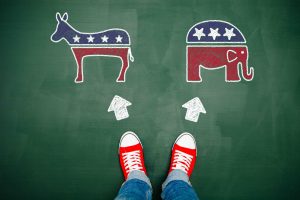Don’t Argue In The Past Tense
Let’s say that Suellen and I have an argument and I notice that all the verbs are in the past tense. According to Aristotle, the verbs tell us that the argument is about blame. I may think it’s about who left the door unlocked or forgot to pay the mortgage. But it’s really about blame.
Let’s also say that I win that argument. (This is very hypothetical). I’ve successfully pushed the blame away from myself and on to her. It’s not easy to win an argument, so I do a little victory dance. Meanwhile, how does Suellen feel? Probably a mixture of emotions – irritation, annoyance, anger, … perhaps even a desire to get even. Suellen is the woman I love. Why on earth would I want her to feel like that? That’s the problem with arguing in the past tense. Even if you win, you lose.
Arguing in the past tense is generally known as forensic rhetoric. In many legal situations, we do want to lay blame. We want to establish guilt and make sure that the appropriate person is appropriately punished. Most of the testimony in a trial is in the past tense. Similarly, characters in crime dramas speak almost exclusively in the past tense. The goal is to lay blame and Aristotle and others give us rules for how to argue the point.
Outside of the courtroom, however, arguing in the past tense is essentially useless. We can’t do anything about the past. We can’t change it. We can’t enhance it. We can lay blame but, even then, we will argue endlessly about whether we got it right or not. Did we blame the right person? If so, did we blame them for the right reasons? Did we learn the right lessons? Did history teach us anything? Or did it teach us nothing?
The next time you’re in an argument, notice the verbs. If they’re in the past tense, you’re simply trying to blame the other person. Does it do any good to “win” such an argument? Nope. By “winning”, you just give the other side motivation to come back stronger next time. This is how feuds get started. The Stoic philosopher, Epictetus, had it right: “Small-minded people blame others. Average people blame themselves. The wise see all blame as foolishness.”
Are Machines Better Than Judges?
Police make about 10 million arrests every year in the United States. In many cases, a judge must then make a jail or bail decision. Should the person be jailed until the trial or can he or she be released on bail? The judge considers several factors and predicts how the person will behave. There are several relevant outcomes if the person is released:
- He or she will show up for trial and will not commit a crime in the interim.
- He or she will commit a crime prior to the trial.
- He or she will not show up for the trial.
A person in Category 1 should be released. People in Categories 2 and 3 should be jailed. Two possible error types exist:
Type 1 – a person who should be released is jailed.
Type 2 – a person who should be jailed is released.
Jail, bail, and criminal records are public information and researchers can massively aggregate them. Jon Kleinberg, a professor of computer science at Cornell, and his colleagues did exactly that and produced a National Bureau of Economic Research Working Paper earlier this year.
Kleinberg and his colleagues asked an intriguing question: Could a machine-learning algorithm, using the same information available to judges, reach different decisions than the human judges and reduce either Type 1 or Type 2 errors or both?
The simple answer: yes, a machine can do better.
Klein and his colleagues first studied 758,027 defendants arrested in New York City between 2008 and 2013. The researchers developed an algorithm and used it to decide which defendants should be jailed and which should be bailed. There are several different questions here:
- Would the algorithm make different decisions than the judges?
- Would the decisions provide societal benefits by either:
- Reducing crimes committed by people who were erroneously released?
- Reducing the number of people held in jails unnecessarily?
The answer to the first question is very clear: the algorithm produced decisions that varied in important ways from those that the judges actually made.
The algorithm also produced significant societal benefits. If we wanted to hold the crime rate the same, we need only have jailed 48.2% of the people who were actually jailed. In other words, 51.8% of those jailed could have been released without committing additional crimes. On the other hand, if we kept the number of people in jail the same – but changed the mix of who was jailed and who was bailed – the algorithm could reduce the number of crimes committed by those on bail by 75.8%.
The researchers replicated the study using nationwide data on 151,461 felons arrested between 1990 and 2009 in 40 urban counties scattered around the country. For this dataset, “… the algorithm could reduce crime by 18.8% holding the release rate constant, or holding the crime rate constant, the algorithm could jail 24.5% fewer people.”
Given the variables examined, the algorithm appears to make better decisions, with better societal outcomes. But what if the judges are acting on other variables as well? What if, for instance, the judges are considering racial information and aiming to reduce racial inequality? The algorithm would not be as attractive if it reduced crime but also exacerbated racial inequality. The researchers studied this possibility and found that the algorithm actually produces better racial equity. Most observers would consider this an additional societal benefit.
Similarly, the judges may have aimed to reduce specific types of crime – like murder or rape – while de-emphasizing less violent crime. Perhaps the algorithm reduces overall crime but increases violent crime. The researchers probed this question and, again, the results were negative. The algorithm did a better job of reducing all crimes, including very violent crimes.
What’s it all mean? For very structured predictions with clearly defined outcomes, an algorithm produced by machine learning can produce decisions that reduce both Type I and Type II errors as compared to decisions made by human judges.
Does this mean that machine algorithms are better than human judges? At this point, all we can say is that algorithms produce better results only when judges make predictions in very bounded circumstances. As the researchers point out, most decisions that judges make do not fit this description. For instance, judges regularly make sentencing decisions, which are far less clear-cut than bail decisions. To date, machine-learning algorithms are not sufficient to improve on these kinds of decisions.
(This article is based on NBER Working Paper 23180, “Human Decisions and Machine Predictions”, published in February 2017. The working paper is available here and here. It is copyrighted by its authors, Jon Kleinberg, Himabindu Lakkaraju, Jure Lesovec, Jens Ludwig, and Sendhil Mullainathan. The paper was also published, in somewhat modified form, as “Human Decisions and Machine Predictions” in The Quarterly Journal Of Economics on 26 August 2017. The paper is behind a pay wall but the abstract is available here).
Segmenting The Body Politic
As a marketing executive, I’m accustomed to the process of segmenting markets. My software companies divided markets by company size, SIC code, geography, and installed software. By doing so, we could identify and communicate with companies that were most likely to buy our products and services.
The Pew Research Center has done something similar with America’s body politic. Rather than two major political parties, Pew identifies eight different clusters of political thought and action: four for the Left and four for the Right. Let’s take a look at each. (Click here for the complete report and here for a Q&A on the methodology).
Among Conservatives
Core Conservatives support traditional Republican positions including smaller government and lower taxes. They also believe that the nation’s economic system is fundamentally fair. Core Conservatives generally support globalization, believing that the global economy creates opportunities for American businesses. This segment accounts for approximately 31% of all Republicans and roughly 13% of the American body politic.
Country First Conservatives are deeply concerned about immigration and generally believe that America should withdraw from the world. They strongly believe that the global economy is deeply threatening to American interests. More than any other segment, Country First Conservatives agree with the statement “If America is too open to people from all over the world, we risk losing our identity as a nation.” This segment accounts for 14% of Republicans and 6% of the American public.
Market Skeptic Republicans share many conservative values but are losing faith in the American economic system. They believe the economy unfairly favors powerful interests and are skeptical of banks and other financial institutions. More than any other group, the disagree with the statement “The U.S. economic system is generally fair to most Americans.” This segment accounts for 22% of Republicans and roughly 12% percent of the American public.
New Era Enterprisers form the most optimistic segment of either the Right or the Left. More than any other group they believe that the next generation of Americans will be better off than the current generation. New Era Enterprisers strongly support business and generally believe that immigrants strengthen the country. This segment makes up 17% of Republicans and 11% of the general public.
Adding it up (with some rounding errors), the four Conservative segments account for approximately 42% of the American body politic.
Among Liberals
Solid Liberals have liberal attitudes across the board. They overwhelmingly support government involvement in health insurance and government activism to ensure that blacks have equal rights with whites. They support government regulation of business and don’t believe one needs to be religious to be moral. Solid Liberals account for 16% of the general public 33% of Democrats.
Opportunity Democrats agree on many policy issues with Solid Liberals. They’re more likely, however, to be pro-business and to believe that most people can get ahead if they work hard. They comprise 12% of the general public and roughly 20% of Democrats.
Disaffected Democrats are positive about the Democratic Party but cynical about government in general. This is one of two minority-majority segments. They support activist government programs and believe that we should focus less on problems abroad and more on domestic issues. Disaffected Democrats account for 14% of the general public and 23% of Democrats.
Devout and Diverse is the second minority-majority segment. Like Disaffected Democrats, they face financial hardships. Among all the groups, this segment is the least politically engaged. They resist government regulation and strongly believe that one needs to believe in God to be moral. The Devout and Diverse account for 9% of the public and 11% of Democrats.
Adding it up, the four Liberal segments account for roughly 51% of the American body politic.
So if Conservatives account for 42% and Liberals for 51% of the general public, where are the rest of our voters? According to Pew, roughly 8% of the general public are Bystanders, described as a “relatively young, largely minority group” that is “missing in action politically”.
So where do you stand? Thanks to the Pew Research Center, you can now find out. Pew has published the Political Typology Quiz. Click here, answer a series of questions, and you can figure out which group most closely represents your worldview. I’ll be writing more about this in the future. You may want to know which group you’re in to follow along.
The Dying Grandmother Gambit
I teach two classes at the University of Denver: Applied Critical Thinking and Persuasion Methods and Techniques. Sometimes I use the same teaching example for both classes. Take the dying grandmother gambit, for instance
In this persuasive gambit, the speaker plays on our heartstrings by telling a very sad story about a dying grandmother (or some other close relative). The speaker aims to gain our agreement and encourages us to act. Notice that thinking is not required. In fact, it’s discouraged. The story often goes like this:
My grandmother was the salt of the earth. She worked hard her entire life. She raised good kids and played by the rules. She never complained; she just worked harder. She worked her fingers to the bone but she was always the picture of health … until her dying days when our government simply abandoned her. As her health failed, she moved into a nursing home. She wanted to stay. She thought she had earned it. But the government did X (or didn’t do Y). As a result, my dying grandmother was abandoned to her fate. She was kicked to the curb like an old soda can. In her last days, she was a tiny, wrinkled prune. She couldn’t hear or see. She just curled up in her bed and waited to die. But our faceless bureaucrats couldn’t have cared less. My grandmother never complained. That was not her way. But she cried. Oh lord, did she cry. I can still see the big salty tears rolling slowly down her cheeks. Sometimes her gown was soaked with tears. How much did the government care? Not a whit. It would have been so easy for the government to change its policy. They could have cancelled X (or done Y). But no, they let her die. Folks, I don’t want your grandparents to die this way. So I’ve dedicated my candidacy to changing the government policy. If I can save just one grandma from the same fate, I’ll consider my job done.
So, do I tell my classes this is a good thing or a bad thing? It depends on which class I’m teaching.
In my critical thinking class I point out the weakness of the evidence. It doesn’t make sense to decide government policy on a sample of one. Perhaps the grandmother represents a broader population. Or perhaps not. We have no way of knowing how representative her story is.
Further, we didn’t meet the dear old lady. We didn’t directly and dispassionately observe her conditions. We didn’t speak to her caretakers. Or to those faceless bureaucrats. We only heard the story and we heard it from a person who stands to benefit from our reaction. She may well have embroidered or embellished the story.
Further, the speaker is playing on the vividness fallacy. We remember vivid things, especially things that result in loss, or death, or dismemberment. Because we remember them, we overestimate their probability. We think they’re far more likely to happen than they really are. If we invoke our critical thinking skills, we may recognize this. But the speaker aims to drown our thinking in a flood of emotions.
In my critical thinking class, I point out the hazards of succumbing to the story. In my persuasion class, on the other hand, I suggest that it’s a very good way to influence people.
The dying grandmother is a vivid and emotional story. It flies below our System 2 radar and aims directly at our System 1. It aims to influence us emotionally, not conceptually. It’s influential because it’s a good story. A story can do what data can never do. It can engage us and enrage us.
Further, the dying grandmother puts a very effective face on the issue. The issue is no longer about numbers. It’s about flesh and blood. We would be very hardhearted to ignore it. So we don’t ignore it. Instead, our emotions pull us closer to the speaker’s position.
So is the dying grandmother gambit good or bad? It’s neither. It just is. We need to recognize when someone manipulates our emotions. Then we need to put on our critical thinking caps.
Designing A Life — Fate and Gravity
I was one of the taller kids in my high school class. I thought – and hoped – that I might use this size advantage to become a star basketball player.
Alas, it was not to be. I had a bad case of what’s often called “white guy’s disease”. Simply put, I couldn’t jump. Though I was over six feet tall, I could barely touch the rim even with my mightiest leap.
Van Jones would call this my fate. In a memorable commencement speech at Loyola New Orleans, Jones distinguished between fate and destiny. He defines fate as “those things that we have no control over” and suggests that the “people who are most miserable in life are the ones who spend their time cursing their fate.” (Click here for the video).
As it happens, the field of design thinking has a similar concept. Dave Evans, a design engineer, calls it the gravity problem. No matter how hard we try, we can’t change gravity. Indeed, we can’t even suspend it temporarily. Wouldn’t it be great to suspend gravity while we’re building a new house and then reinstate it when we move in? Unfortunately, we can’t. Time to move on. (For a podcast featuring Evans, click here).
Gravity is a fact of life. My inability to jump is a fact of my life. Instead of asking, “How can I change my fate?” it’s better to accept it and ask more useful questions. A useful question is one that we can actually do something about. A designer would say that we need to design around the constraints.
As Evans describes it, we’re looking for room to maneuver around the facts that define our products or our lives. I couldn’t jump very high. That’s a design constraint. So I might ask a different question: “How can I make basketball an important part of my life, even though I can’t play very well?” Once I ask the how can I question, I can dream up alternatives. I might become a coach. Or a sportscaster. Or I might decide to take up a sport that doesn’t require jumping.
Van Jones calls this destiny as opposed to fate. We have no control over fate. But we can respond to destiny. As Jones points out, “The world is not going to tell you every day about …” your destiny. We have to live our lives, and respond to our challenges, to discover our destiny.
Whether we call it destiny or design thinking, when we bump up against gravity, we need to change the question. By doing so, we can find an array of alternatives. Once armed with a list of alternatives, we can design a life or a product. Which alternatives fit the constraints? Which ones don’t?
We don’t design a product and then launch it. Rather we design it, then re-design it, then re-design it as we discover new constraints. Similarly, it’s difficult to design a life before we launch it. To overcome fate and discover our destiny, we need to design our lives as we live them.




